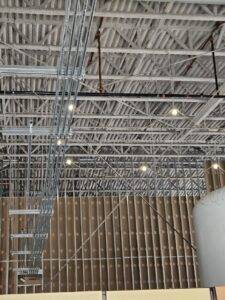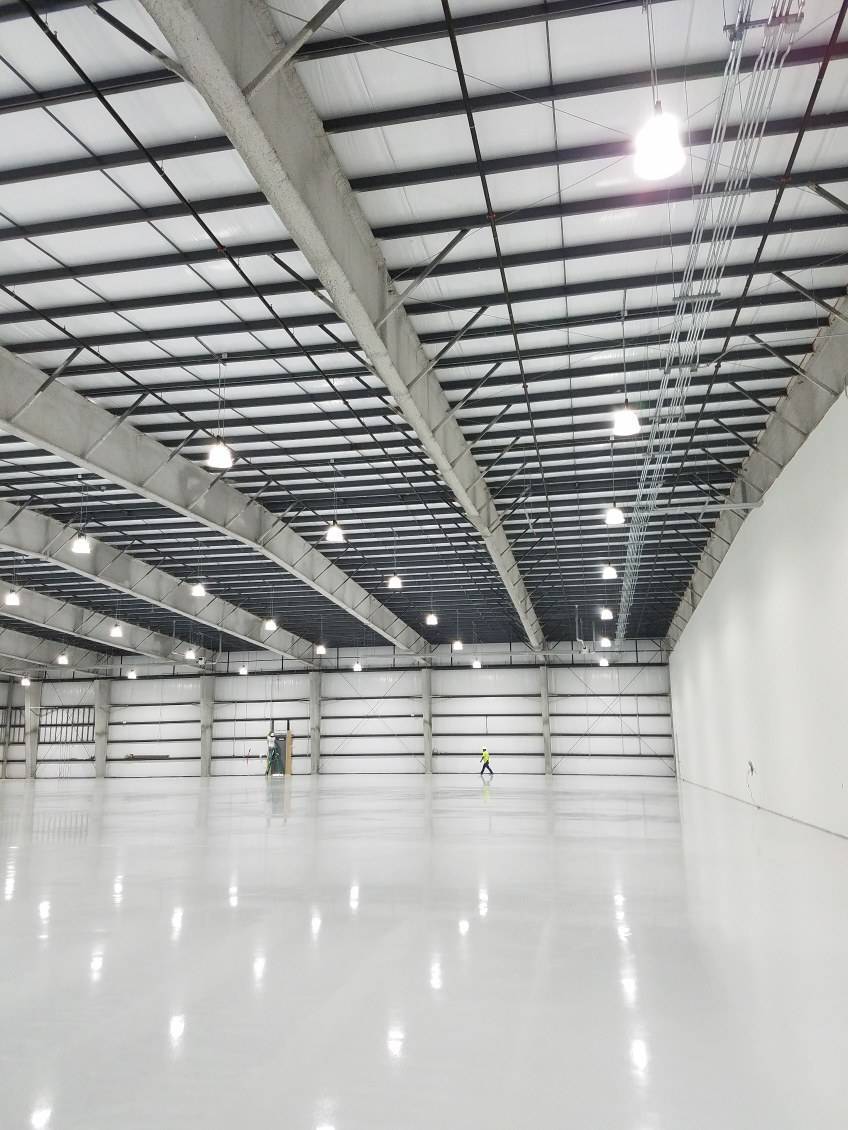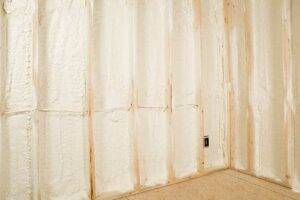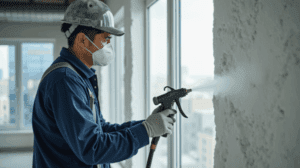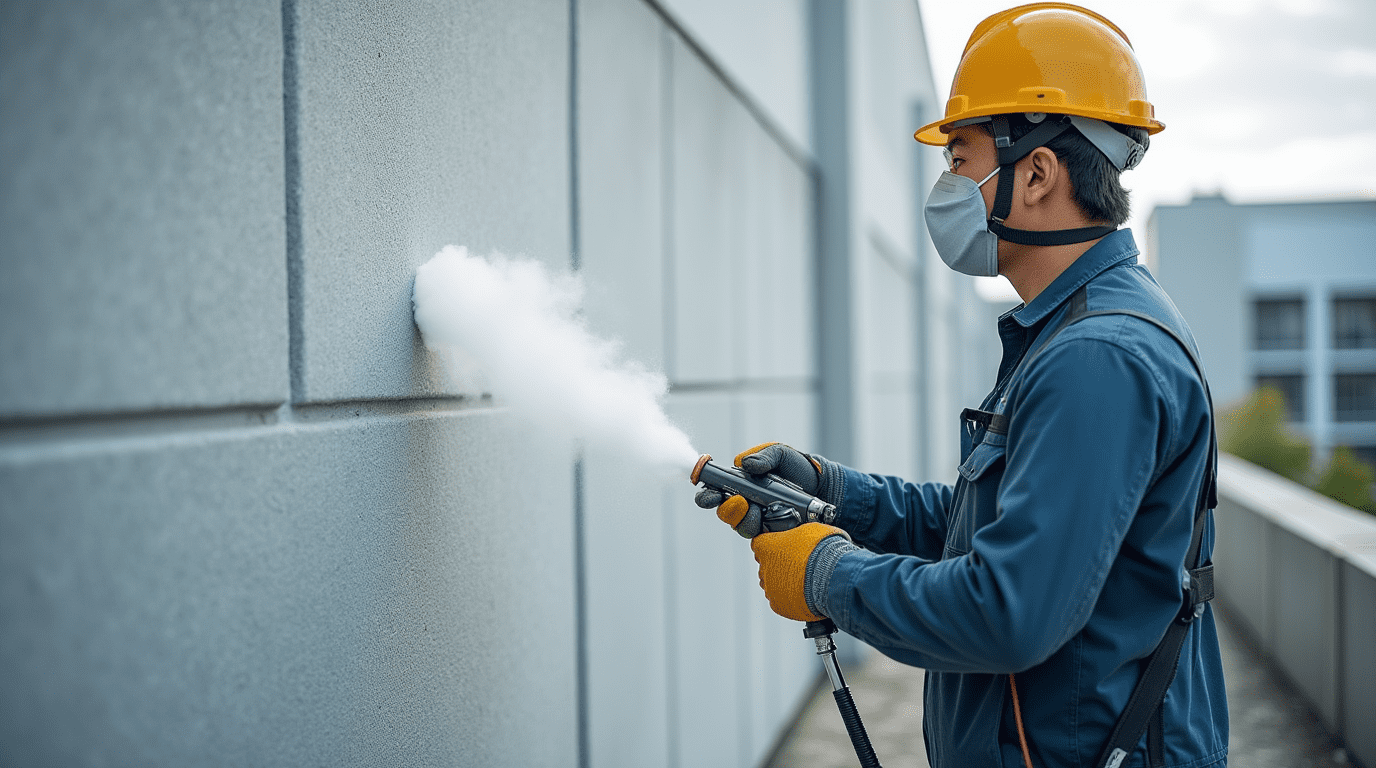K-13 Insulation: Cost Savings and Acoustic Control for Commercial Spaces
Bahl Fireproofing

K-13 Insulation: Cost Savings and Acoustic Control for Commercial Spaces
Summary
K-13 spray-applied cellulose insulation delivers dual-function performance for commercial and industrial facilities by combining thermal insulation with acoustic control in a single application. This article examines how K-13’s verified R-value of 3.7 to 3.75 per inch and NRC ratings from 0.90 to 1.05 address energy efficiency and noise reduction simultaneously, reducing both installation costs and project complexity compared to separate insulation and acoustic treatment systems.
TLDR: K-13 spray-applied cellulose insulation provides R-3.7 to R-3.75 per inch thermal resistance and NRC ratings up to 1.05 for acoustic control in one application. The system installs faster than separate insulation and acoustic panels, reduces labor costs, and delivers verified performance in warehouses, manufacturing facilities, gymnasiums, and office spaces. Facilities upgrading from minimal insulation typically see energy cost reductions of 20-30% while simultaneously addressing noise control requirements, though results vary based on baseline conditions and climate factors.
Installing spray-applied cellulose insulation isn’t like rolling out fiberglass batts. K-13 requires specialized equipment, trained applicators, and precise technique to deliver the thermal and acoustic performance that commercial facilities depend on. But when you need both energy efficiency and noise control, K-13 eliminates the complexity of coordinating separate insulation and acoustic contractors.
Over 20 years of fireproofing and insulation work, I’ve seen facility managers struggle with the same problem repeatedly: they insulate for energy savings, then discover they need acoustic treatment for noise control. Now they’re managing two contractors, two schedules, and two budgets. K-13 addresses both requirements in one application, installed by one crew, with one warranty.
The material itself is straightforward. K-13 is a spray-applied cellulose fiber insulation composed of 99% recycled newspaper content. It bonds directly to metal decking, concrete, drywall, and most structural substrates without requiring adhesives or mechanical fasteners. The fibers interlock as they’re sprayed, creating a seamless monolithic blanket that controls both heat transfer and sound transmission.
Why Modern Facilities Need Dual-Function Performance
Commercial and industrial buildings face dual performance mandates that traditional insulation systems address separately. Energy codes require specific R-values to control heating and cooling costs. Meanwhile, occupational safety regulations, building codes, and tenant requirements often demand acoustic treatment to maintain productive work environments and meet noise exposure limits.
The traditional approach installs rigid board insulation or spray foam for thermal performance, then adds acoustic panels or tiles for noise control. This strategy works, but it doubles material costs, extends installation schedules, and creates coordination challenges between trades.
K-13 spray-applied insulation changes this equation by delivering both functions simultaneously. The same cellulose fiber matrix that traps air pockets to slow heat transfer also absorbs sound energy to reduce reverberation and echo. Facilities get code-compliant thermal resistance and acoustic control from a single application, installed in days rather than weeks.
According to Department of Energy guidance on commercial building insulation, spray-applied cellulose provides effective thermal performance and air sealing capabilities that contribute to whole-building energy efficiency. When properly applied to metal deck, concrete, or other structural substrates, K-13 provides continuous coverage without thermal bridging or acoustic gaps that compromise performance.
How K-13 Delivers Verified Thermal and Acoustic Performance
K-13’s performance characteristics come from its physical structure and composition. The material consists of cellulose fibers treated with non-toxic fire retardants to achieve Class A fire ratings per ASTM E84 testing (flame spread 25, smoke developed 50). When pneumatically sprayed onto substrates, these fibers create a dense, interlocking matrix with consistent thermal and acoustic properties.
Thermal Performance: K-13 provides R-3.7 to R-3.75 per inch of applied thickness according to manufacturer technical data sheets verified through ASTM C518 testing. A 3-inch application delivers approximately R-11 thermal resistance, while 4-inch thickness achieves approximately R-15. This performance remains stable over the material’s 75-year service life, with no settling or compression that degrades effectiveness over time.
Acoustic Performance: NRC ratings for K-13 range from 0.90 to 1.05 depending on thickness and substrate configuration. At 2-inch thickness over solid backing, K-13 achieves NRC 1.00. At 1.5-inch thickness on ribbed metal deck, the material achieves NRC 1.05 due to additional absorption from air spaces behind the deck profile. These ratings are verified through ASTM C423 testing protocols conducted by independent acoustical laboratories.
Fire Protection Applications: K-13 is UL listed and approved for use over spray fireproofing in various BXUV Guide Design Assemblies, making it suitable for facilities requiring both structural fire protection and thermal or acoustic performance from coordinated systems.
The material bonds mechanically to substrates through fiber interlocking, creating seamless coverage without joints or fastener penetrations. This monolithic application eliminates thermal bridging at seams and maintains consistent acoustic absorption across the entire treated surface. Unlike batt insulation that can gap at edges or acoustic panels that leave spaces between tiles, K-13 covers completely.
Cost Analysis: Single System vs. Separate Solutions
The economic advantage of K-13 becomes clear when comparing total installed costs for thermal and acoustic performance against separate system approaches. For a typical 20,000 square foot warehouse ceiling requiring R-13 thermal insulation and NRC 0.85 acoustic treatment:
Separate Systems: Rigid board insulation plus acoustic ceiling panels typically cost $3.75-$6.00 per square foot installed, with 2-3 weeks project duration requiring trade coordination.
K-13 Single System: K-13 at 3.5 inches (delivering approximately R-13 and NRC 1.00) typically costs $2.25-$3.50 per square foot installed, with 4-6 days project duration using a single crew.
For this facility, K-13 typically reduces total installation costs by $30,000 to $50,000 while cutting project duration in half, though actual savings depend on local labor rates, substrate conditions, and project-specific factors.
Energy cost reduction adds ongoing value beyond installation savings. Facilities upgrading from minimal or degraded insulation to code-compliant R-values typically reduce heating and cooling costs by 20-30% as documented in manufacturer and DOE data, though actual results depend on climate zone, utility rates, building envelope quality, and HVAC system efficiency.
Real Project Performance: Texas Distribution Center
Last year we completed a K-13 installation at a 35,000 square foot distribution facility outside Round Rock. The metal building had minimal original insulation and significant noise issues from forklift operation and package handling equipment. Daytime interior temperatures regularly exceeded 95°F during summer months despite continuous air conditioning.
The facility manager needed both thermal upgrades to reduce energy costs and acoustic treatment to meet OSHA noise exposure requirements for warehouse staff. We applied 3-inch K-13 to the underside of the metal roof deck over five days with a three-person crew.
Post-installation monitoring showed interior temperatures stabilized at 78-82°F during peak summer conditions, representing a 13-15°F reduction from baseline. The facility’s monthly cooling costs dropped from approximately $4,200 to $2,800 during summer months, a 33% reduction. OSHA-compliant noise measurements showed ambient noise levels decreased from 87-89 dB to 78-81 dB, bringing the facility into compliance without requiring hearing protection for most work areas.
This project represents documented performance in a real-world application. Your specific results will depend on existing conditions, building envelope quality, local climate factors, and HVAC system efficiency.
Comparing K-13 to Alternative Systems
Spray Foam Insulation: Closed-cell spray foam delivers higher R-value per inch (R-6 to R-7) but provides minimal acoustic performance (NRC around 0.70). Facilities needing noise control must add separate acoustic treatment, eliminating cost advantages. Open-cell spray foam offers modest acoustic improvement (NRC 0.75-0.80) but remains inferior to K-13’s verified NRC performance above 0.90.
Fiberglass Batt Insulation: Batts cost less initially ($0.75-$1.50 installed) but provide minimal acoustic performance (NRC 0.80-0.85) and require separate acoustic treatment. Manufacturer lifespan ratings claim 50-100 years when properly installed and undisturbed, but real-world performance typically degrades within 15-20 years due to compression, moisture absorption, and settling.
Rigid Board Insulation: Polyisocyanurate and EPS rigid boards deliver consistent R-values (R-5 to R-6.5 per inch) but provide virtually no acoustic benefit and require mechanical fastening. These systems work well for applications requiring only thermal performance but fail to address acoustic requirements that K-13 handles simultaneously.
Maintenance and Long-Term Performance
K-13’s 75-year service life assumes proper installation and normal building conditions. The material requires minimal maintenance compared to other insulation and acoustic systems. The cellulose fiber matrix does not settle, compress, or degrade under normal conditions. Unlike batt insulation that sags over time or blown insulation that requires periodic topping, K-13 maintains both thermal and acoustic performance indefinitely once cured.
However, K-13 is not appropriate for all environments. High-humidity applications (sustained relative humidity above 80%) may require vapor barriers or climate control to prevent moisture accumulation. Areas with direct water exposure or condensation require proper building envelope design to protect the insulation.
Frequently Asked Questions
Does K-13 require a separate vapor barrier or air barrier?
K-13 itself provides moderate air resistance but is not classified as an air barrier or vapor retarder. Most applications over metal deck in climate-controlled spaces require no additional vapor barrier. However, facilities in cold climates or high-humidity environments should consult with design professionals about vapor barrier requirements based on specific conditions.
Can K-13 be applied to existing insulation or must old insulation be removed?
K-13 bonds best to clean, structurally sound substrates. Existing insulation should be removed if it’s compressed, contaminated, or poorly performing. However, K-13 can be applied over existing spray foam or rigid board insulation in good condition when additional R-value or acoustic performance is needed.
How does K-13 perform in areas with temperature extremes or thermal cycling?
The cellulose fiber structure remains dimensionally stable across temperature ranges from -40°F to 180°F, making it suitable for both cold storage applications and hot climates. Unlike rigid foam products that can crack or delaminate under thermal cycling, K-13’s flexible fiber matrix accommodates building movement and thermal expansion without performance degradation.
What certifications and testing verify K-13’s performance claims?
K-13 holds Class A fire rating per ASTM E84 testing with flame spread 25 and smoke developed 50. Thermal performance is verified through ASTM C518 testing showing R-3.7 to R-3.75 per inch. Acoustic performance is documented through ASTM C423 reverberation room testing conducted by independent laboratories. The material carries GREENGUARD Gold certification for indoor air quality.
How quickly can a facility be occupied after K-13 installation?
K-13 is non-toxic and requires no occupancy restrictions during or after installation. The material is applied damp and dries through natural air circulation over 24-48 hours. Light construction activity can resume within hours of application completion, though we recommend allowing overnight drying before resuming full operations to prevent surface damage.
Key Takeaways
- K-13 delivers verified R-3.7 to R-3.75 per inch thermal resistance and NRC ratings from 0.90 to 1.05 in a single application, eliminating the need for separate insulation and acoustic systems in most commercial facilities.
- Total installed costs for K-13 typically run $2.25-$3.50 per square foot, representing potential savings of 30-40% compared to installing separate thermal insulation and acoustic panels, though actual costs vary by project.
- Facilities upgrading from minimal insulation to code-compliant R-values with K-13 typically see energy cost reductions of 20-30%, though results depend on baseline conditions, climate factors, and building envelope quality.
- The material’s 75-year service life and stable performance eliminate maintenance costs and replacement cycles associated with batt insulation or acoustic panels that degrade over time.
- Installation by trained applicators takes days rather than weeks, reducing project duration and allowing faster building occupancy compared to coordinating separate insulation and acoustic contractors.
Get Dual-Function Performance Without Compromise
If your facility needs both energy efficiency and noise control, coordinating separate insulation and acoustic contractors adds cost, complexity, and schedule delays you don’t need. K-13 spray-applied cellulose delivers both requirements in one application, installed by one crew, with verified performance that lasts decades.
At Bahl Fireproofing, we’ve installed K-13 in warehouses, manufacturing facilities, office buildings, and specialty applications throughout Texas, Kansas, and Oklahoma. We understand the installation techniques that deliver manufacturer-specified performance and the building science principles that make dual-function systems work. Contact Bahl Fireproofing today to discuss how K-13 can address your facility’s thermal and acoustic requirements in a single cost-effective solution.
Disclaimer: This article provides general educational information about fireproofing and insulation systems and does not constitute professional engineering advice or product specification. System selection must be based on project-specific fire ratings, thermal requirements, acoustic performance needs, environmental conditions, substrate requirements, and budget constraints. Code requirements vary by jurisdiction and project type. Always consult with a licensed professional and verify UL or FM assembly listings before finalizing specifications.

